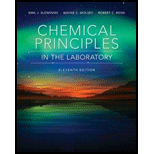
Concept explainers
A
a. How many moles of
_______moles
b. How many moles of
____________ moles
c. What is the molar mass of the unknown acid? (Use Eq.4.)
____________ g/mol
Trending nowThis is a popular solution!

Chapter 24 Solutions
Chemical Principles in the Laboratory
- Consider the following acids and bases: HCO2H Ka = 1.8 104 HOBr Ka = 2.0 109 (C2H5)2NH Kb = 1.3 103 HONH2 Kb = 1.1 108 Choose substances from the following list that would be the best choice to prepare a pH = 9.0 buffer solution. a. HCO2H b. HOBr c. KHCO2 d. HONH3NO3 e. (C2H5)2NH f. (C2H5)2NH2Cl g. HONH2 h. NaOBrarrow_forwardDraw the general titration curve for a strong acid titrated by a strong base. At the various points in the titration, list the major species present before any reaction takes place and the major species present after any reaction takes place. What reaction takes place in a strong acidstrong base titration? How do you calculate the pH at the various points along the curve? What is the pH at the equivalence point for a strong acidstrong base titration? Why?arrow_forwardMalonic acid (HO2CCH2CO2H) is a diprotic acid. In the titration of malonic acid w ith NaOH, stoichiometric points occur at pH = 3.9 and 8.8. A 25.00-mL sample of malonic acid of unknown concentration is titrated with 0.0984 M NaOH, requiring 31.50 mL of the NaOH solution to reach the phenolphthalein end point. Calculate the concentration of the initial malonic acid solution. (Sec Exercise 113.)arrow_forward
- a Draw a pH titration curve that represents the titration of 25.0 mL of 0.15 M propionic acid. CH3CH2COOH, by the addition of 0.15 M KOH from a buret. Label the axes and put a scale on each axis. Show where the equivalence point and the buffer region are on the titration curve. You should do calculations for the 0%, 50%, 60%, and 100% titration points. b Is the solution neutral, acidic, or basic at the equivalence point? Why?arrow_forwardIn an acid-base titration, 21.16 mL of an NaOH solution are needed to neutralize 20.04 mL of a 0.0997 M HCl solution. To find the molarity of the NaOH solution, we can use the following procedure: First note the value of MH in the HCl solution. ____________M Find MOH- in the NaOH solution. Use Eq.3. ____________M Obtain MNaOH from MOH. ____________Marrow_forwardRepeat the procedure in Exercise 61, but for the titration of 25.0 mL of 0.100 M pyridine with 0.100 M hydrochloric acid (Kb for pyridine is 1.7 109). Do not calculate the points at 24.9 and 25.1 mL.arrow_forward
- A 0.210-g sample of an acid (molar mass = 192 g/mol) is titrated with 30.5 mL of 0.108 M NaOH to a phenolphthalein end point. Is the acid monoprotic, diprotic, or triprotic?arrow_forwardstion 1 Calculate the pH of the titration of 50 mL 0.05 M HCI with 0.10 M NaOH a) Oml NaOH b.) 10 ml NaOH c.) 20 ml NaOH d.) 24 ml NaOH e.) 24.10 mL NaOH f.) 25 mL NaOH g.) 25.10 ml NaOH h.) 26 mL NaOH Express the answers in 3 SF. P Earrow_forward3 Part Question; Please help: 1. Calculate the pH at the stoichiometric point when 75 mL of 0.095M formic acid is titrated with 0.33 M NaOH. 2. Calculate the pH at the stoichiometric point when 25 mL of 0.088 M pyridine is titrated with 0.31 M HCl. 3. Calculate the pH at the stoichiometric point when 75 mL of 0.084 M hydrochloric acid is titrated with 0.32 M NaOH.arrow_forward
- What is the pH when 50 ml 0.1 M NaOH is added to 50 ml the solution mixture of 0.1 M НА and O.1 M НС (Ка %3D 10 - 6) а. 4 b. 7 с. 7.65 d. 3.65 e. 2.65arrow_forwardNot Secure- gmc.mrooms3.net glish United States (en_us) When titrating a weak base with HCI at 25°C, the Select one: a. pH will be less than 7 at the equivalence point. O b. pH will be equal to 7 at the equivalence point. O C. pH will be greater than 7 at the equivalence point. O d. titration will require more moles of base than acid to reach the equivalence point. e. titration will require more moles of acid than base to reach the equivalence point.arrow_forwardThis is about determinition of acid content in vinegar through titration, please answer the questions. Please answer only the items nummber 4-5. i only put other questions for guide. 1. What is the purpose of standardization? 2. What is the primary standard used (name and formula)? ANS: KHP 3. Suppose that the KHP is not completely dry. Will the reported molar concentration of the sodium hydroxide solution be higher, lower, or unaffected? Explain. 4. In preparing the buret for titration the final rinse is with the NaOH titrant rather than with distilled water. Explain. 5. The procedure suggests the addition of only 2 drops of phenolphthalein. What will be the effect to the analysis if larger amount of phenolphthalein is added?arrow_forward
 Chemical Principles in the LaboratoryChemistryISBN:9781305264434Author:Emil Slowinski, Wayne C. Wolsey, Robert RossiPublisher:Brooks Cole
Chemical Principles in the LaboratoryChemistryISBN:9781305264434Author:Emil Slowinski, Wayne C. Wolsey, Robert RossiPublisher:Brooks Cole
 ChemistryChemistryISBN:9781305957404Author:Steven S. Zumdahl, Susan A. Zumdahl, Donald J. DeCostePublisher:Cengage Learning
ChemistryChemistryISBN:9781305957404Author:Steven S. Zumdahl, Susan A. Zumdahl, Donald J. DeCostePublisher:Cengage Learning Chemistry: An Atoms First ApproachChemistryISBN:9781305079243Author:Steven S. Zumdahl, Susan A. ZumdahlPublisher:Cengage Learning
Chemistry: An Atoms First ApproachChemistryISBN:9781305079243Author:Steven S. Zumdahl, Susan A. ZumdahlPublisher:Cengage Learning General Chemistry - Standalone book (MindTap Cour...ChemistryISBN:9781305580343Author:Steven D. Gammon, Ebbing, Darrell Ebbing, Steven D., Darrell; Gammon, Darrell Ebbing; Steven D. Gammon, Darrell D.; Gammon, Ebbing; Steven D. Gammon; DarrellPublisher:Cengage Learning
General Chemistry - Standalone book (MindTap Cour...ChemistryISBN:9781305580343Author:Steven D. Gammon, Ebbing, Darrell Ebbing, Steven D., Darrell; Gammon, Darrell Ebbing; Steven D. Gammon, Darrell D.; Gammon, Ebbing; Steven D. Gammon; DarrellPublisher:Cengage Learning





